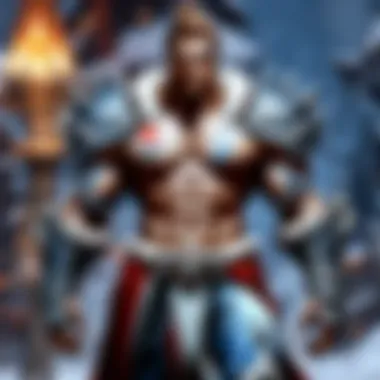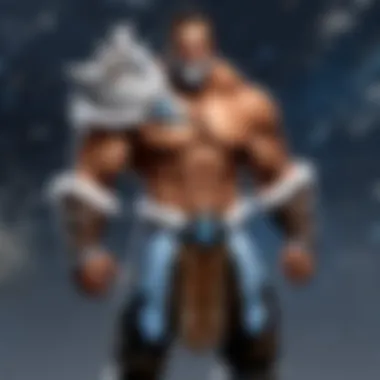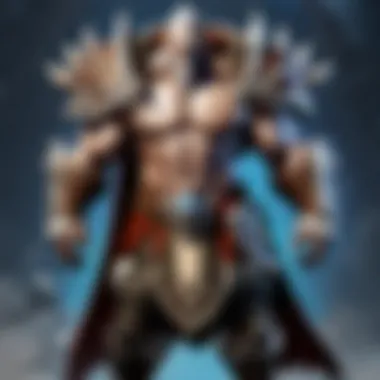Exploring Cast Player Dynamics in Blizzard Games


Intro
In the realm of video gaming, few developers have shaped genres and fan expectations quite like Blizzard Entertainment. Its games are not just pastimes but a way of life for many players, with dedicated communities that thrive on character selection and strategy. The cast player dynamic is an intricate facet that can make or break the gaming experience. At its core, the dynamics are rooted in the choices players make regarding their characters and how those choices interplay with game mechanics and broader community trends.
Understanding these dynamics is crucial for anyone diving into Blizzard’s universe - from the casual gamer to the zealous competitor. Each character has unique abilities, strengths, and weaknesses that can influence the course of gameplay and community interaction in notable ways. As we navigate through this article, expect to explore how player decisions shape not just individual gameplay but also the ecosystem at large.
The Concept of Cast Players
When we talk about cast players within the realm of Blizzard games, we’re diving into a fundamental aspect of gameplay that shapes not only individual performances but also community interactions and strategic depth. Cast players represent a unique category of participants whose ability to select, strategize, and execute character abilities can redefine the gaming experience. Their role extends beyond mere character choice; it involves understanding game dynamics, collaborative synergies, and the intricate balance of competition.
Cast players bring a richness to gameplay that enhances how others perceive and engage within the game. Their decisions can affect team dynamics, influence victory or defeat, and contribute to the overall atmosphere in competitive scenarios. At the core of their importance lies a triad of elements: decision-making, team interaction, and character mastery.
Defining Cast Players
In simplest terms, cast players are those who primarily engage in skills and abilities that require active casting in gameplay. Think of them as the spell-casters or ability-users whose roles are typically highlighted in various Blizzard titles, such as Overwatch or World of Warcraft. These players focus on maximizing their character’s potential by learning in-depth mechanics and optimal approaches to their skills.
However, defining cast players goes beyond their ability to use specific powers. It's about their mentality and approach to leveraging game mechanics, often becoming adept at identifying opportunities in fast-paced environments. This can mean knowing when to unleash a critical ability or how to position oneself strategically for maximum impact.
"The art of casting is not just in the spells you send forth, but in the moments of anticipation before they fly."
Role in Gameplay Dynamics
The role of cast players in gameplay dynamics is multifaceted. Firstly, their presence often dictates how matches unfold. For instance:
- Influencing Team Composition: A team lacking in bombastic spell casters might struggle against opponents with strong area-effect abilities. Cast players, therefore, help shape team strategies and compositions.
- Shaping Meta Trends: As players embrace certain characters or tactics that reflect their potent abilities, these preferences can create shifts in player strategies or even the broader competitive environment. For example, if everyone starts to favor a particular caster, that character may soon become a top-tier selection, changing the dynamics of competitive matches.
- Establishing Thematic Cohesion: Cast players often embody certain themes, enhancing the narrative and fun of the gameplay. A team full of creative spell-wielders can immerse players in fantasy or sci-fi settings, granting depth to character choices and enhancing the shared experience.
Ultimately, the actions and choices of cast players ripple through matches, affecting everyone involved. They breathe life into strategies, pivot the flow of gameplay, and often serve as the lynchpin in tight moments, making their understanding crucial not only for themselves but for their teammates too.
Character Selection Process
The character selection process is a pivotal element in Blizzard's games that sets the tone for the entire gameplay experience. It’s not just about picking a hero or a character; it influences how the match will unfold, affects team dynamics, and ultimately defines the strategies employed throughout the game. Each decision made during this phase has repercussions that echo in every encounter that follows. Players often weigh their options carefully, aiming to balance personal playstyle with the collective needs of their team. Understanding this intricate process gives players a leg up in both casual and competitive settings.
Factors Influencing Choices
Several factors can shape the character choices players make in Blizzard games. These factors can drastically alter how a game plays out:
- Personal Playstyle: Some players thrive in aggressive roles; some prefer a supportive stance, while others excel in strategic control. The character selected often mirrors the player's inherent skills or preferred approach to gameplay.
- Team Composition: Character selection is rarely done in isolation. Players often consider the overall synergy of their team. For instance, selecting a healer when a team is short on support can turn the tide in tight matches. Conversely, too many damage dealers can lead to imbalance, leaving the team vulnerable.
- Meta Trends: The metagame, meaning the prevailing strategies or character choices that dominate a season, significantly impacts selections. For example, if a particular character is seen as too powerful, players are likely to gravitate toward that character, hoping to secure a competitive edge.
- Map Specificity: Certain maps may favor different character types. Players often think on their feet; for example, a character with mobility features may be more beneficial on a sprawling map compared to a compact setting where a heavy character might shine.
In essence, character selection becomes a multi-faceted decision, driven by an array of influences that converge to shape the game experience for everyone involved.
Metagame Considerations
Metagame considerations play a significant role in character selection. This encompasses the strategies, character picks, and counter-picks that evolve over time, reflective of community trends and developer patches. Here are some key aspects:


- Evolving Strategies: As players discover how characters interact with one another, the meta often shifts. One character might rise to prominence due to a new strategy that other players adopt, forcing a counter-strategy discussion. The cycle can prompt players to adapt swiftly, always staying one step ahead.
- Patch Notes Impact: Blizzard frequently updates its games, tweaking character abilities or overall balance. These changes can render previous strategies obsolete or less effective and compel players to rethink their character choices, further influencing what is popular at any given time.
- Community Input: Platforms like Reddit and community forums serve as melting pots for metagame discussions. Players share insights about character effectiveness, providing valuable resources for others attempting to navigate the complexities of character selection.
"Every patch, every new hero, every change can redefine what is viable. It's like a chess game, where the pieces are constantly shifting; you either adapt, or you get left behind."
So, keeping a finger on the pulse of the metagame is crucial. Gamers can boost their performance by aligning their choices with the evolving landscape of character effectiveness and team dynamics.
Cast Player Strengths and Weaknesses
Understanding the strengths and weaknesses of cast players is crucial for anyone looking to excel in Blizzard games. These elements not only affect personal performance but also shape how teams strategize and respond to various in-game scenarios. A deep grasp of what makes each cast player unique can turn the tide in competitive scenarios and enhance enjoyment during casual play. Thus, recognizing both abilities and limitations informs better decision-making, promoting collaboration within teams and elevating the gaming experience.
Character Abilities and Traits
In the realm of cast players, character abilities and traits define how individuals contribute within their teams. Each character in Blizzard games such as Overwatch or World of Warcraft encompasses a set of abilities that dictate their role in battle. Some characters might focus on dealing damage, while others provide support or tanking functions. For instance, Ana in Overwatch is often seen as a pivotal healer, possessing the ability to heal allies from a distance or inflict damage on enemies. This duality can be harnessed effectively based on the situation, showcasing the importance of understanding a character's strengths.
Furthermore, abilities often come with cooldowns – moments when they cannot be used again. This factor requires cast players to time their moves strategically. Knowing when to unleash a powerful attack or when to hold back can distinguish seasoned players from novices. Traits such as mobility can also dictate how well a character interacts with their environment. Characters like Tracer are designed for agility and can traverse battlefields swiftly, allowing for both offensive and evasive maneuvers.
The mastery of abilities and traits guides not just an individual player, but also serves as a compass for team tactics during gameplay.
Situational Limitations
While strengths are valuable, recognizing situational limitations is equally important for any cast player. No character is invincible; each one has specific vulnerabilities and scenarios where they may struggle. For example, a character like Bastion, revered for its high damage output while in turret mode, is inflexible and easily countered by enemies who can flank and eliminate it quickly.
Cast players must adapt to different environments. Certain characters might excel in close-quarter combat but flounder in open spaces, where distance becomes an enemy's ally. It's practical for a team to be aware of these limitations and to strategize around them. Similarly, understanding when not to engage or retreating at the right moment is critical. Situational awareness can often mean the difference between victory and defeat.
Another limitation stems from the in-game meta, which evolves as players experiment and learn. A character that is effective today may become less so tomorrow if opponents develop effective counter strategies. For instance, if a particular character is dominating the play field, other players tend to adapt and utilize characters that can counter it effectively.
In summary, recognizing both strengths and weaknesses creates a fuller picture of the cast player dynamic. This allows for better gameplay not just for individuals, but also boosts teamwork and, ultimately, enjoyment in Blizzard’s diverse gaming experiences.
Influence of Game Design
The intricate web of gameplay in Blizzard games is tightly woven around the design philosophies adopted by the developers. Understanding how game design influences cast player dynamics is crucial for both seasoned players and newcomers alike. Game design isn’t just about aesthetics or mechanics; it fundamentally shapes the player’s experience and the role cast players fulfill within that environment. This discussion zeroes in on two pivotal elements in this regard: Developer Intent and Player Experience, and Balancing Mechanisms.
Developer Intent and Player Experience
Developer intent is the guiding force behind every game element. Blizzard's designers prioritize creating a rich narrative, diverse character abilities, and environments that enhance the gameplay experience for cast players. This focus ensures that every cast player feels connected to their character, thus enhancing engagement.
Blizzard often emphasizes how character abilities should align with the overall game mechanics, pushing players to synergize with their team. Take, for instance, the Overwatch game where developers intentionally designed characters like Zarya and Reinhardt to complement each other. This pairing nurtures strategic decision-making and illustrates how developer intent serves to foster collaboration among players.
Moreover, the player experience is enhanced through visual storytelling and responsive designs that push players to adapt their strategies depending on the character they select. A well-designed game not only reflects the developers' intentions but also responds to player feedback. This adaptability leads to an evolving meta, keeping the gameplay fresh and exciting.
"The most important thing about a game’s design is how it interacts with the player; it’s all about creating that perfect balance."
Balancing Mechanisms
Balancing mechanisms are the unsung heroes of game design, ensuring a level playing field for all cast players, regardless of experience or character choice. Blizzard has a reputation for fine-tuning character abilities to strike a balance that prevents any single character from becoming overly dominant. This is particularly relevant in titles like Hearthstone, where card interactions require ongoing adjustments to maintain competitive integrity.


The balancing process involves constant monitoring of gameplay statistics and player feedback. Developers frequently employ patches to adjust character strengths and weaknesses, ensuring game balance is maintained. This ongoing dialogue between players and developers is vital, as it allows the game to evolve alongside its community.
Consider common scenarios where a character might be perceived as overpowered; a developer may implement a slight nerf to its abilities based on win-rate statistics. This isn’t merely about reducing power; it’s about creating an atmosphere where choices matter and each cast player feels their contributions are significant.
Community Interaction and Cast Players
Understanding how players interact with one another is essential when discussing cast players in Blizzard games. Community plays a crucial role in shaping how individuals perceive characters, strategies, and overall gameplay. Engaging with fellow players not only enhances one’s skills but also fosters a sense of belonging and collective knowledge sharing. This interchange can lead to a richer gaming experience and strengthens the bonds among enthusiasts.
Player Collaboration and Coordination
Talking about collaboration, it's pretty clear that most Blizzard games are designed with teamwork in mind. Take Overwatch, for instance: the focus on diverse character abilities creates a landscape where collaboration shines. Players often find that they can’t go at it solo if they wish to achieve success in objectives or team compositions. Whether it's coordinating attacks, sharing healing responsibilities, or even calling out enemy positions, teamwork can turn the tide in many matches.
- Communication is Key: Utilizing tools such as voice chat or textual messaging helps in rallying together plans and adapting strategies on-the-fly. Whether it's launching a surprise attack or defending an objective, proper communication can’t be emphasized enough.
- Role Clarity: Each player's role must be clear. This doesn’t just involve sticking to one type of character; it also means knowing when to switch mid-game if the situation demands it. A high-damage character may need to transition into a support role, depending on how the game unfolds.
"Effective teamwork often separates the victors from the vanquished."
In situations where members adapt and align with each other’s strategies, players can leverage their character strengths to preprocess the enemy’s weaknesses, turning discrepancies into advantages for their team.
Competitive Play Dynamics
When it comes to competitive play, the dynamics shift significantly. StarCraft II is a prime example where players regularly evaluate their choices based on both personal gameplay and what their opponents bring to the table. Understanding the ecosystem within these games is vital.
- Anticipating Moves: Knowing what your opponent might do next can substantially influence your own strategies. Players invest time in studying trends and often review past games to gauge potential weaknesses to exploit.
- Meta Awareness: The competitive scene is ever-changing, which means players must stay updated with the latest patch notes and community discussions. Characters may fluctuate in effectiveness based on frequent updates. Engaging in community forums or following discussions on platforms like reddit can provide invaluable insights.
This constant interplay between player synergy and competitive evasion cultivates a vibrant gaming environment where cast players evolve. As they learn from others, they become more than just a sum of their casting choices; they morph into informed strategists capable of nuanced decision-making under pressure, enhancing both personal performance and team success.
Strategies for Effective Casting
The intricacies of casting in Blizzard games can make or break a player's experience. Effective casting not only enhances individual performance but also influences overall team dynamics. In this section, we will explore how cast players adapt their strategies to meet various challenges and their significance in both casual and competitive settings.
Adaptation to Team Needs
Adapting to team needs is paramount for any cast player. Each match presents its unique scenarios, requiring players to cooperate and fulfill specific roles that benefit the group. Firstly, recognizing what your team lacks is crucial. If a team is light on damage, a cast player might consider selecting a character with higher damage output, shedding their preferred playstyle for the sake of team synergy.
For example, imagine a team composed mainly of support characters. A player opting for a damage-dealing caster becomes an invaluable asset, shifting the scales in their favor during intense battles. One of the key aspects here is communication. A cast player who actively engages with their teammates can pinpoint gaps in strategy and fill them swiftly. Positioning oneself as a versatile element allows for a more cohesive gameplay experience.
Additionally, practicing flexibility and switching characters mid-game in response to unexpected situations ensures that a team remains competitive. Understanding both the strengths and weaknesses of your chosen character is necessary; otherwise, it’s like bringing a butter knife to a gunfight.
Countering Opponent Strategies
Being aware of how to counter opponent strategies is another critical facet of effective casting. Blizzard games often feature a hotbed of diverse characters and playstyles, making strategic adaptability essential. Players need to gauge their opponents' moves, recognizing patterns and exploiting weaknesses.
For instance, if an enemy team leans heavily into defensive strategies, a cast player can counteract this by selecting characters with abilities to break shields or control enemy positions. This might involve using AoE attacks or crowd control, pushing the enemy out of their comfort zone.
Moreover, players can benefit from researching popular strategies that opponents might deploy. Websites like reddit.com often share insights and player experiences that reveal trends and tactics to watch for. Implementing counter-strategies becomes less daunting when players familiarize themselves with the meta and have a toolkit ready for any situation.


Furthermore, understanding opponent caster abilities allows for tactical planning. If a player anticipates an enemy's ult, preemptive actions can be taken—playing it cool and smart can tip the scales in your favor. Adept cast players will learn to predict moves, almost as if they are playing a high-stakes game of chess.
By combining both adaptations to team needs and countering opponent strategies, cast players not only improve their individual gameplay but significantly contribute to their team's success. As the adage goes, ‘a chain is only as strong as its weakest link.’ Breaking down barriers through effective casting strategies cultivates team synergy like nothing else.
Educational Resources for Players
When discussing the dynamics of cast players in Blizzard games, the significance of educational resources cannot be overstated. Available materials empower both new and experienced players, enhancing their understanding of character mechanics, game strategies, and community interactions. These resources serve as stepping stones that can elevate a player's experience and effectiveness in gameplay, making the exploration of them vital to the discourse.
Tutorials and Workshops
Blizzard games often present intricate gameplay systems where every character has unique abilities and interactions with others. Tutorials and workshops play an essential role in helping players navigate these complexities. Consider a new player stepping into Overwatch, for instance; they might feel overwhelmed by the array of characters and their roles. A well-structured tutorial guides them step by step, explaining how a solid tank can soak damage while support characters are crucial for keeping the team afloat.
Moreover, workshops often provide a hands-on approach to learning that can significantly benefit players. For example, communities or gaming clubs often sponsor live workshops, where players can practice and get immediate feedback from mentors or fellow gamers. During these events, players learn valuable lessons on teamwork and strategy that are often neglected in solo play.
- Benefits of such resources include:
- Enhanced understanding of character abilities
- Real-time feedback
- Improved coordination with team members
It’s often mentioned that "practice makes perfect," but few recognize the importance of guided practice. Workshops can also showcase advanced techniques that may not be apparent through traditional gameplay, giving players a leg up on the competition.
Community Forums and Discussions
Community forums, like those found on Reddit or specialized Blizzard fan sites, serve as a treasure trove of shared knowledge. Players from different backgrounds and skill levels convene to discuss strategies, share experiences, and offer tips on overcoming challenges in-game. For instance, one might discover a thread on the effective use of Zeratul in StarCraft II, explaining the nuances of blink timing and positioning in engagements.
Engaging in these discussions not only enriches a player's strategic repertoire but also fosters a sense of camaraderie among gamers. When individuals share their struggles, victories, and even failures, it humanizes the experience and builds connections based on mutual understanding.
"A key facet of successful gaming involves not just individual skill, but the ability to leverage collective insights from a broader community."
In summary, educational resources, encompassing both tutorials and community discussions, are indispensable for players aiming to master the nuances of cast dynamics in Blizzard games. By seeking knowledge and engaging with the community, players can enhance their gameplay while forging lasting relationships, ultimately deepening their appreciation for the strategic tapestry woven within these virtual worlds.
Future of Cast Players in Blizzard Games
The future possibilities for cast players in Blizzard games are as rich as the colorful worlds crafted by the developers themselves. Understanding where these dynamics are headed not only generates excitement but also amplifies strategy potential for both casual and competitive gamers. With a rapidly evolving gaming landscape, the patterns that emerge can have tangible implications on how players interact, collaborate, and confront challenges.
Emerging Trends
In recent times, we're witnessing a shift in player interactions with characters, influenced by technological advances as well as community feedback. For instance, the introduction of AI-based matchmaking is creating a new layer of complexity in choosing which cast players to utilize. Players look beyond just stats; they're also considering team synergy, character adaptability, and even emotional resonance with the characters. These emerging trends create a landscape where versatility is praised, and players often invest time into mastering multiple characters to fit varying scenarios.
- Character Diversity: The recent expansion packs like Shadowlands have diversified the cast, asking players to navigate a wider array of skills and strengths. This encourages creative strategies and fosters deeper community discussions about ideal team compositions.
- In-Game Communication Tools: Games are developing enhanced communication options, allowing players to coordinate efforts through streamlined chat systems or designated roles. This cultivates better teamwork and strategy execution, crucial for advanced gameplay dynamics.
- Live Events and Tournaments: Frequent live events heighten engagement levels, pushing players to adapt and rethink casting choices depending on what they observe in competitive play. Such competitive formats spark new metas and force players to remain agile in their tactical approaches.
Amidst all this, the player's adaptability stands out as one of the critical skills—those who can pivot effectively between different roles will thrive.
Anticipated Game Developments
Peering into the crystal ball, we can identify nuanced developments that could reshape the future dynamics of cast players. For instance:
- Advanced Character Customization: Blizzard has teased future updates that expand the customization potential for characters. These changes might allow deeper personalization of abilities or skins that can resonate more with individual players, making their connection stronger with the characters they choose.
- Enhanced Player Feedback Mechanisms: As the industry pivots towards player input, there may be systems instated which allow cast players to provide feedback on character balance or gameplay styles. This could foster a more responsive development cycle where players feel their insights could directly inform future patch notes.
- Cross-Game Collaboration: Such collaborations might hint at characters crossing over into different game universes. These crossovers could also lead to exciting combinations of character abilities, encouraging players to explore new combinations and strategies.
"Innovation doesn’t come from a place of comfort, it often arises in the throes of challenge. The more we observe, the better prepared we become for the evolution ahead."
The question remains: how can players prepare for these changes? By remaining actively engaged with both community discussions and updates, players can better equip themselves with the knowledge to adapt, ensuring their casting remains relevant in the face of inevitable change.



